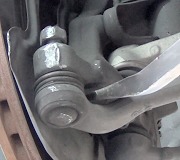There's no easy way to tell when the ball joint is dry unless you remove the dust boot. I suspect he just couldn't find the grease fitting since they are kind of hidden in a pocket that the joint sits in. It's also possible the grease fitting is snapped off. You might be able to unscrew the remaining part with an "easy out".
Adding grease to a joint during other routine service such as oil changes is a good way to push out water that might have gotten into it, but unless that boot is split, that grease isn't going anywhere so the joint won't be completely dry. It is also not the "load carrying" joint. It doesn't hold up the weight of the vehicle like the lower one does. It's only job is to hold the wheel straight up and down. That means there isn't nearly as much force acting on it as on the lower joint.
As a point of interest, when you have a periodic inspection of the steering and suspension systems, there must never be any sideways movement between the ball and socket of any ball joint. Also, there should not be any up and down movement between the ball and socket, ... Except on Dakotas. It is perfectly normal to have 1/8" of vertical play in the lower ball joints only, not the upper ones. New aftermarket ball joints may not have that free play but it is acceptable for them to develop that free play later. New ball joints from the dealer have that free play right out of the box and will not cause any noise or problem with the alignment. I'm not aware of any other vehicle this applies to, so don't be surprised if a mechanic tells you they need to be replaced. They are just uninformed and probably won't believe you.
Tuesday, March 29th, 2011 AT 11:21 PM



